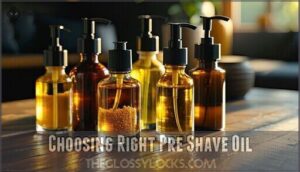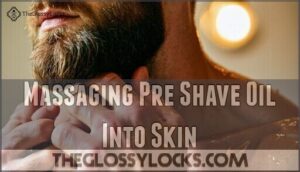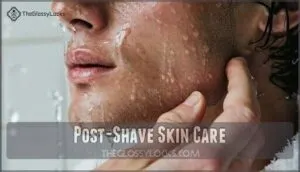This site is supported by our readers. We may earn a commission, at no cost to you, if you purchase through links.

Start with warm water to soften hair follicles, then apply a gentle cleanser to remove dirt and oil.
Pre-shave oil is your secret weapon – it creates a protective barrier between your razor and skin.
Jojoba oil works well for most skin types, while coconut oil offers natural antibacterial properties.
You can also use hair conditioner or aloe vera gel as alternatives.
The key is creating slip and hydration so your razor glides effortlessly, which helps to make an ordinary shave into something your skin will thank you for.
These simple steps transform an ordinary shave into something your skin will actually thank you for.
Table Of Contents
- Key Takeaways
- Pre Shave Preparation
- Alternatives to Shaving Cream
- Choosing Right Pre Shave Oil
- Pre Shave Techniques and Tips
- Post Shave Skin Care
- Frequently Asked Questions (FAQs)
- What to do before shaving cream?
- What products should you use before shaving?
- What should I apply on skin before shaving?
- What to apply instead of shaving cream?
- How long should pre-shave products stay on skin?
- Should you shave immediately after showering or wait?
- Do pre-shave products expire and lose effectiveness?
- Conclusion
Key Takeaways
- Prep your skin with warm water and a gentle cleanser – You’ll soften hair follicles and remove dirt that can dull your blade, creating the perfect foundation for a smooth shave.
- Apply pre-shave oil as your secret weapon – Jojoba or argan oil creates a protective barrier between the razor and skin, letting your blade glide effortlessly while preventing razor burn.
- Don’t skip alternatives when you’re out of shaving cream – Hair conditioner, aloe vera gel, or even coconut oil work just as well to provide lubrication and protect your skin from irritation.
- Time your routine for maximum effectiveness – Let the pre-shave oil absorb for 1-2 minutes before shaving, and always shave with the grain to minimize tugging and prevent ingrown hairs.
Pre Shave Preparation
Proper pre-shave preparation sets the foundation for a smooth shave that won’t leave your skin feeling like sandpaper.
You’ll want to focus on hydrating your skin, softening those stubborn hair follicles, and creating a protective barrier that reduces friction and prevents the dreaded razor burn.
Hydrating The Skin
Why worry about skin hydration when you could be cutting through stubble like butter? Properly hydrated skin creates the perfect foundation for your hydrating shave, preventing those dreaded nicks and razor burn that make you look like you wrestled with a cheese grater.
Here’s how to achieve ideal skin hydration:
- Water Retention – Soak your skin for 15 minutes before shaving to maximize moisture absorption
- Skin Barrier Protection – Apply natural moisturizers like coconut oil to lock in hydration
- Humectants Benefits – Use products with glycerin or hyaluronic acid to draw moisture from the air
- Dehydration Effects Prevention – Avoid hot water that strips your skin’s natural oils, leading to skin dryness
To further enhance the process, consider a consistent skincare routine.
Softening Hair Follicles
Warm water opens hair follicles, making them easier to cut.
Pre-shave oils provide absorption time that softens stubborn whiskers before you apply shaving cream. Natural options like jojoba oil work well for hair softening and skin preparation.
Exfoliating before shaving removes dead skin cells that can trap hairs. This shaving preparation step prevents tugging and makes your razor glide smoothly, ensuring a comfortable shave with smoothly gliding razors.
Reducing Friction
Friction becomes your enemy when metal meets skin. Pre shave oil creates the perfect slippery surface, letting your razor glide smoothly without tugging or pulling. This lubricant properties boost transforms an ordinary shave into something comfortable and controlled.
Transform metal-meets-skin warfare into silk-smooth victory with the right pre-shave armor.
Here’s how to master razor glide:
- Apply pre shave oil to damp skin – Creates an essential skin barrier between blade and face
- Check your shaving angle – Keep blade at 30 degrees for ideal blade sharpness contact
- Use light pressure – Let the razor’s weight do the work, not your hand
- Choose quality shaving cream alternative – Hair conditioner or coconut oil provides excellent lubrication
- Maintain proper shaving preparation – Clean, warm skin accepts products better than cold, dirty surfaces
Preventing Irritation
Preventing skin irritation starts with blade sharpness—dull razors tug at hair, causing razor burn and bumps.
Always test new products with a patch-test on your wrist before applying to sensitive areas.
Shaving direction matters: go with the grain to minimize friction.
Pre shave oil creates a protective barrier that enhances shaving oil benefits.
Proper post-shave care and understanding your skin sensitivity help prevent ingrown hair formation.
Alternatives to Shaving Cream
You don’t need expensive shaving cream to get a smooth, comfortable shave when you have these household alternatives right at your fingertips.
Natural oils, baby products, and everyday lotions can work just as well as traditional shaving cream while offering unique skin benefits, such as providing a smooth and comfortable shave.
Natural Oils Like Coconut and Olive
Natural oils offer gentle alternatives when you’re out of shaving cream.
These kitchen staples can save your skin from razor burn while providing nourishing benefits.
Benefits of natural oils for pre-shave preparation:
- Coconut oil moisturizes deeply but avoid on face due to comedogenicity
- Olive oil provides vitamins E and K, though it feels greasy
- Application techniques require warming small amounts between palms first
- Skin types respond differently – test oils on small patches initially
- Moisturizing oils create protective barriers that prevent water loss
Both coconut and olive oils work as effective pre shave oil alternatives.
Apply sparingly to damp skin for best results.
Aloe Vera Gel and Baby Oil
Aloe vera gel delivers cooling effects and skin hydration that make it a standout shaving cream alternative.
You’ll find baby oil creates a protective barrier while moisturizing sensitive areas.
Both options offer gentle, skin-soothing benefits for pre shave preparation. Aloe benefits include natural cooling properties, while baby oil uses extend to hypoallergenic protection for delicate skin during shaving, providing skin hydration.
Lotion and Creams for Skin Hydration
Regular lotion and creams you already own can work wonders for shaving lubrication.
Face, hand, or body lotions create a protective barrier that helps your razor glide smoothly while keeping skin hydrated.
Test different lotion types on a small patch first, especially if you have sensitive skin.
Rich creams with glycerin or shea butter work best for dry skin, while lighter formulas suit combination skin.
Apply enough to cover the area without rubbing it in completely for ideal shaving lubrication.
For enhanced hydration, consider options that offer moisturizing properties.
Hair Conditioner for Softening Hair
Hair conditioner isn’t just for your locks—it’s a surprisingly effective shaving cream alternative that softens body hair while providing comparable hydration.
The conditioner ingredients create a protective barrier, allowing your razor to glide smoothly across skin.
Apply a thin layer, let it sit for application time of 1-2 minutes, then shave with the grain.
Discover conditioner shaving cream for a smoother shave. Rinse thoroughly afterward to prevent clogged pores and enjoy post-shave benefits like moisturized skin.
Choosing Right Pre Shave Oil
You’ll need the right pre-shave oil to create a protective barrier that prevents razor burn and irritation.
Different skin types require specific oils, so choosing wisely can transform your daily shave from a chore into a comfortable experience.
Jojoba Oil for Combination Skin
Jojoba oil stands out as the perfect match for combination skin types.
This liquid wax closely mimics your skin’s natural sebum, helping balance oily and dry zones without clogging pores.
Its non-comedogenic properties mean you won’t wake up with breakouts, while its impressive absorption rate guarantees quick penetration.
Apply a few drops to damp skin, and you’ll notice how jojoba benefits both moisture regulation and razor glide improvement.
It’s also known for its antioxidant and vitamin content, which is great for the skin.
Argan Oil for Dry or Aging Skin
With aging skin as your canvas, argan oil delivers powerful pre-shave benefits that’ll transform your routine.
This vitamin E powerhouse boosts hydration levels while supporting aging prevention through its rich antioxidant profile. Argan oil contains beneficial oleic and linoleic acids that help maintain skin hydration.
Argan benefits for dry skin include:
- Deep skin moisturizing that penetrates without clogging pores
- Enhanced elasticity and firmness for mature skin
- Anti-inflammatory properties that calm irritation
- Natural barrier protection during shaving
Application tips: Warm a few drops between your palms, then massage into damp skin using circular motions. Allow this pre shave oil to absorb for 1-2 minutes before applying your regular skin care routine.
Pre Shave Oil Ingredients to Avoid
Read ingredient labels carefully when choosing pre shave oil.
Avoid comedogenic oils like coconut oil on your face, as they’ll clog pores.
Certain products address comedogenic oils for face.
Steer clear of artificial fragrances and alcohol content, which cause irritating reactions.
Skip products with harsh chemicals, drying agents, or petroleum byproducts.
Watch for carcinogenic compounds hiding in ingredient lists.
Your skin deserves better than these troublemakers.
Hypoallergenic Options for Sensitive Skin
Looking for gentler options on your skin? Fragrance-free creams with chamomile benefits and vitamin E work wonderfully as hypoallergenic shaving substitutes.
Aloe vera gel provides natural cooling while gentle cleansers prep sensitive skin effectively. These shaving cream alternatives won’t trigger reactions like traditional products might.
Explore options for fragrance-free shaving needs for sensitive skin. Always patch-test new options first—your skin will thank you later, and consider sensitive skin and hypoallergenic needs.
Pre Shave Techniques and Tips
You’ll need the right techniques to maximize your pre-shave routine’s effectiveness. Proper application and timing can transform an ordinary shave into a smooth, irritation-free experience.
Massaging Pre Shave Oil Into Skin
Warm the best pre shave oil between your palms before applying to damp skin.
Use circular massage motions to work the beard oil deep into hair follicles, softening hair for better skin readiness.
This technique enhances oil absorption and prepares your face better than any shaving cream alternative or pre shave scrub.
Many users prefer beard oil application for superior results.
Allowing Oil to Absorb Before Shaving
Once you’ve massaged the best pre shave oil into your skin, patience becomes your ally.
Allow 1-2 minutes for oil absorption time before picking up your razor.
Your skin will signal its readiness – hair feels softer, skin appears smooth and hydrated.
Sensitive area absorption may need an extra minute, especially around your neck or jawline.
This waiting period lets warm oil benefits fully activate, creating the perfect foundation for your preshave cream or shaving oil to work effectively.
Exfoliating to Prevent Ingrown Hairs
Gentle exfoliating before shaving lifts trapped hairs and removes dead skin cells that cause ingrown hairs.
Use a soft scrub or exfoliating glove 2-3 times weekly—never daily, as this irritates sensitive skin.
Focus on circular motions in problem areas to improve your shaving experience.
This simple preshave routine dramatically improves your best pre shave results and prevents painful bumps.
Shaving With The Grain to Reduce Irritation
Shaving with the grain follows your hair’s natural growth pattern, dramatically reducing skin irritation and razor burn prevention.
This technique minimizes tugging that causes ingrown hairs and inflammation.
Run your hand across the shaving area to feel grain direction – hair lies flat when stroked correctly.
Adjust your shaving angle accordingly, moving the razor in smooth, gentle strokes, which is the best pre shave practice that works with any shaving cream alternative, protecting your skin from unnecessary trauma, and ensuring a safe and gentle shave.
Post Shave Skin Care
Your skin needs proper care after shaving to prevent irritation and maintain its health.
The right post-shave routine can make the difference between smooth, comfortable skin and razor burn that lasts for days.
Applying Moisturizer to Hydrate Skin
Moisturizer replenishes lost hydration after shaving, preventing dryness and flakiness.
Choose moisturizer types based on your skin’s needs—lightweight gels for oily skin, rich creams for dry skin.
Apply within minutes of shaving while pores remain open.
Look for ingredient benefits like glycerin, shea butter, or hyaluronic acid for ideal hydration levels.
Post-shave products like balms can protect skin.
Those with skin sensitivity should select fragrance-free formulas to avoid irritation.
Using Aftershave or Alternative Moisturizers
After moisturizing, aftershave completes your postshave care routine by providing antibacterial protection and skin soothing benefits.
Traditional alcohol-based formulas prevent infection but can sting, while modern balms offer hydration importance through gentle, moisturizing ingredients.
Alternative moisturizers work equally well for sensitive skin concerns.
- Choose alcohol-free balms with aloe vera or chamomile for sensitive skin
- Apply aftershave by patting gently rather than rubbing to avoid irritation
- Consider fragrance-free lotions with glycerin for effective skin hydration
- Test new products on a small patch before full application methods
- Select moisturizers with hyaluronic acid for enhanced product selection benefits
Soothing Skin With Aloe Vera or Toner
After applying moisturizer, your skin needs that final calming touch. Aloe vera gel delivers cooling effects and irritation reduction like a gentle breeze on sunburned skin.
This natural skin calming agent works better than most commercial products for post-shave soothing.
| Product Type | Best For | Key Benefit |
|---|---|---|
| Aloe vera gel | All skin types | Natural cooling and healing |
| Witch hazel toner | Oily/acne-prone | Antiseptic and pore-tightening |
| Rose water toner | Sensitive skin | Gentle hydration and pH balance |
Choose alcohol-free toner types to avoid drying your freshly shaved skin.
Protecting Skin From UV Damage With Sunscreen
After soothing your skin, you’ll want to shield it from harmful UV rays.
Freshly shaved skin is more vulnerable to sun damage, making sunscreen application critical. Apply broad-spectrum SPF 30+ sunscreen to protect your skin barrier.
UV protection prevents darkening and irritation in shaved areas. Reapplication frequency matters—reapply every two hours for ideal shaving safety and long-term skin health, ensuring overall skin health.
Frequently Asked Questions (FAQs)
What to do before shaving cream?
Cleanse your face gently to remove dirt and oil that could cause irritation.
Apply pre-shave oil to soften hair and create a protective barrier, making your upcoming shave smoother and more comfortable.
What products should you use before shaving?
Start with a gentle cleanser to remove dirt and oils that can dull your razor.
Apply pre-shave oil next—it softens hair and creates a protective barrier, making your shave smoother and more comfortable.
What should I apply on skin before shaving?
Before shaving, cleanse your skin with warm water to remove dirt and open pores.
Apply pre-shave oil like jojoba or argan to soften hair and create a protective barrier, massaging gently for better absorption.
What to apply instead of shaving cream?
You can substitute hair conditioner, coconut oil, baby oil, olive oil, aloe vera gel, or body lotion for shaving cream.
These alternatives provide lubrication and protection while moisturizing your skin effectively.
How long should pre-shave products stay on skin?
Allow pre-shave oil to absorb for 1-2 minutes before shaving.
This softens hair and hydrates skin properly.
Wait until your skin feels smooth and hair appears softer—rough hair means you need more time.
Should you shave immediately after showering or wait?
Ironically, rushing into shaving right after showering isn’t always best.
Wait 2-3 minutes after your shower to let your skin cool slightly.
This prevents excessive softening that can lead to nicks and cuts while maintaining ideal hair hydration.
Do pre-shave products expire and lose effectiveness?
Yes, pre-shave products do expire and lose effectiveness over time.
You’ll notice oils becoming rancid, gels separating, or reduced moisturizing power.
Check expiration dates and replace products that smell off or change texture for the best results.
Conclusion
Research shows that 40% of men experience shaving irritation weekly, yet most skip pre-shave preparation entirely.
Understanding what to use before shaving cream transforms your routine from painful to pleasurable.
Pre-shave oils, warm water, and gentle cleansers create the foundation for comfortable shaving. You’ll reduce nicks, cuts, and razor burn while achieving closer results.
Whether you choose jojoba oil, aloe vera, or hair conditioner, proper preparation makes all the difference. Your skin deserves this extra step, and you’ll notice improved comfort immediately, which is key to a pleasurable routine.
- https://dermatologyofct.com/the-dermatologists-guide-to-healthy-shaving-prepping-shaving-and-choosing-the-right-aftershave/
- https://www.wilkinsonsword.com/blogs/mens/what-to-put-on-your-skin-pre-post-shave
- https://www.thepersonalbarber.com/blogs/guides/how-to-get-the-perfect-wet-shave-a-step-by-step-guide
- https://www.gillette.co.uk/blog/how-to-shave/prepare-skin-for-shaving/
- https://www.kiehls.in/how-to-shave













